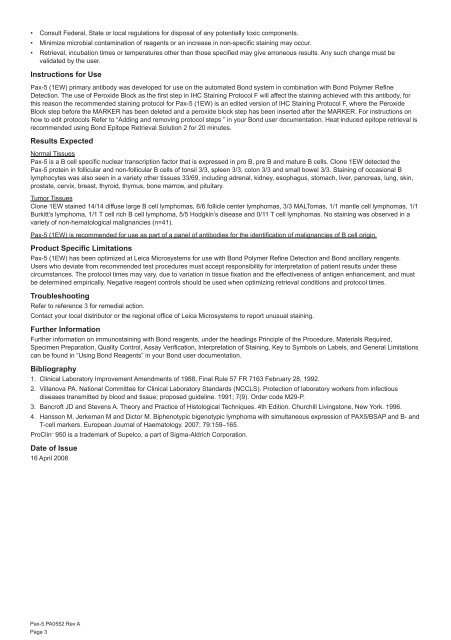Bond™ Ready-To-Use Primary Antibody Pax-5 (1EW)
Bond™ Ready-To-Use Primary Antibody Pax-5 (1EW)
Bond™ Ready-To-Use Primary Antibody Pax-5 (1EW)
You also want an ePaper? Increase the reach of your titles
YUMPU automatically turns print PDFs into web optimized ePapers that Google loves.
•<br />
•<br />
Consult Federal, State or local regulations for disposal of any potentially toxic components.<br />
Minimize microbial contamination of reagents or an increase in non-specific staining may occur.<br />
• Retrieval, incubation times or temperatures other than those specified may give erroneous results. Any such change must be<br />
validated by the user.<br />
Instructions for <strong>Use</strong><br />
<strong>Pax</strong>-5 (<strong>1EW</strong>) primary antibody was developed for use on the automated Bond system in combination with Bond Polymer Refine<br />
Detection. The use of Peroxide Block as the first step in IHC Staining Protocol F will affect the staining achieved with this antibody, for<br />
this reason the recommended staining protocol for <strong>Pax</strong>-5 (<strong>1EW</strong>) is an edited version of IHC Staining Protocol F, where the Peroxide<br />
Block step before the MARKER has been deleted and a peroxide block step has been inserted after the MARKER. For instructions on<br />
how to edit protocols Refer to “Adding and removing protocol steps ” in your Bond user documentation. Heat induced epitope retrieval is<br />
recommended using Bond Epitope Retrieval Solution 2 for 20 minutes.<br />
Results Expected<br />
Normal Tissues<br />
<strong>Pax</strong>-5 is a B cell specific nuclear transcription factor that is expressed in pro B, pre B and mature B cells. Clone <strong>1EW</strong> detected the<br />
<strong>Pax</strong>-5 protein in follicular and non-follicular B cells of tonsil 3/3, spleen 3/3, colon 3/3 and small bowel 3/3. Staining of occasional B<br />
lymphocytes was also seen in a variety other tissues 33/69, including adrenal, kidney, esophagus, stomach, liver, pancreas, lung, skin,<br />
prostate, cervix, breast, thyroid, thymus, bone marrow, and pituitary.<br />
Tumor Tissues<br />
Clone <strong>1EW</strong> stained 14/14 diffuse large B cell lymphomas, 6/6 follicle center lymphomas, 3/3 MAL<strong>To</strong>mas, 1/1 mantle cell lymphomas, 1/1<br />
Burkitt’s lymphoma, 1/1 T cell rich B cell lymphoma, 5/5 Hodgkin’s disease and 0/11 T cell lymphomas. No staining was observed in a<br />
variety of non-hematological malignancies (n=41).<br />
<strong>Pax</strong>-5 (<strong>1EW</strong>) is recommended for use as part of a panel of antibodies for the identification of malignancies of B cell origin.<br />
Product Specific Limitations<br />
<strong>Pax</strong>-5 (<strong>1EW</strong>) has been optimized at Leica Microsystems for use with Bond Polymer Refine Detection and Bond ancillary reagents.<br />
<strong>Use</strong>rs who deviate from recommended test procedures must accept responsibility for interpretation of patient results under these<br />
circumstances. The protocol times may vary, due to variation in tissue fixation and the effectiveness of antigen enhancement, and must<br />
be determined empirically. Negative reagent controls should be used when optimizing retrieval conditions and protocol times.<br />
Troubleshooting<br />
Refer to reference 3 for remedial action.<br />
Contact your local distributor or the regional office of Leica Microsystems to report unusual staining.<br />
Further Information<br />
Further information on immunostaining with Bond reagents, under the headings Principle of the Procedure, Materials Required,<br />
Specimen Preparation, Quality Control, Assay Verification, Interpretation of Staining, Key to Symbols on Labels, and General Limitations<br />
can be found in “Using Bond Reagents” in your Bond user documentation.<br />
Bibliography<br />
1. Clinical Laboratory Improvement Amendments of 1988, Final Rule 57 FR 7163 February 28, 1992.<br />
2. Villanova PA. National Committee for Clinical Laboratory Standards (NCCLS). Protection of laboratory workers from infectious<br />
diseases transmitted by blood and tissue; proposed guideline. 1991; 7(9). Order code M29-P.<br />
3. Bancroft JD and Stevens A. Theory and Practice of Histological Techniques. 4th Edition. Churchill Livingstone, New York. 1996.<br />
4. Hansson M, Jerkeman M and Dictor M. Biphenotypic bigenotypic lymphoma with simultaneous expression of PAX5/BSAP and B- and<br />
T-cell markers. European Journal of Haematology. 2007; 79:159–165.<br />
ProClin 950 is a trademark of Supelco, a part of Sigma-Aldrich Corporation.<br />
Date of Issue<br />
16 April 2008<br />
<strong>Pax</strong>-5.PA0552 Rev A<br />
Page 3
















